MXA RACE TEST: THE REAL TEST OF THE 2022 KAWASAKI KX450
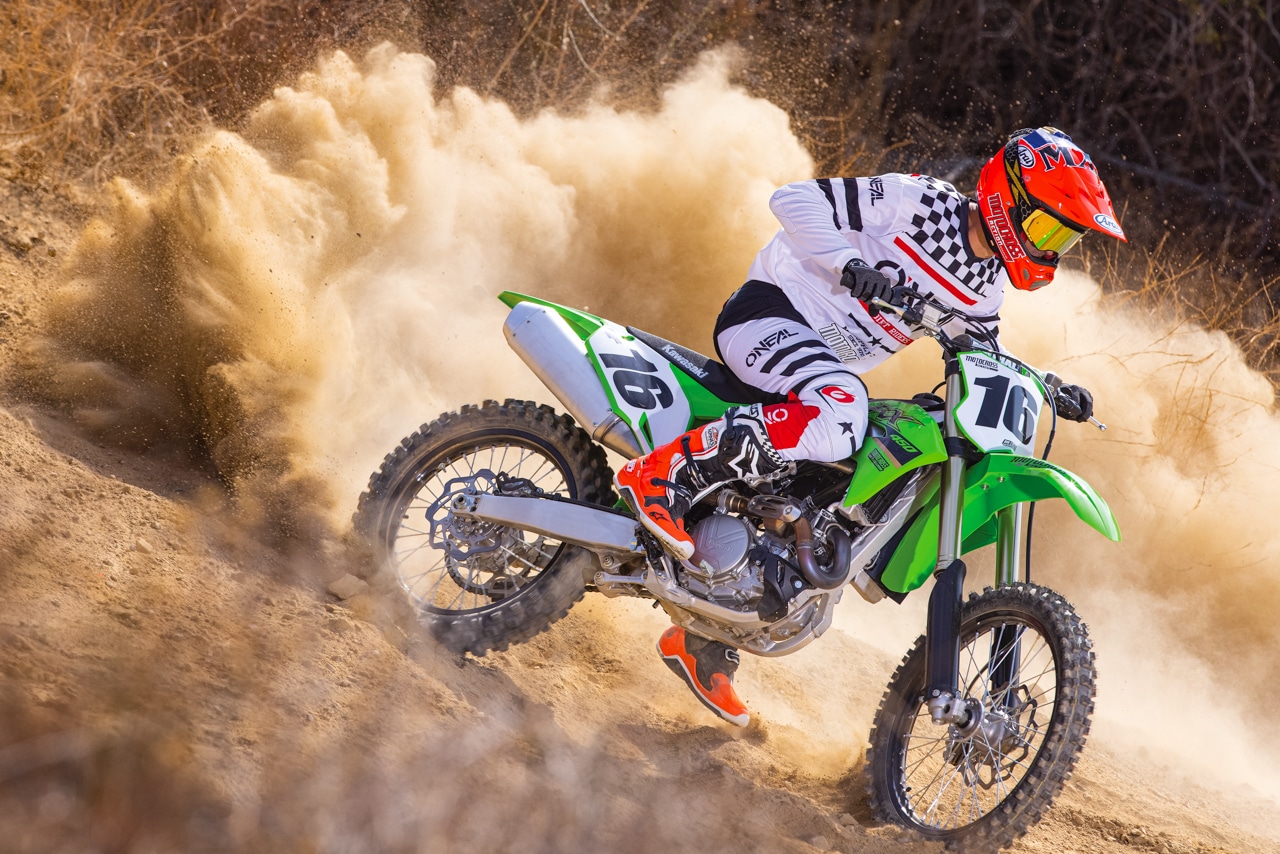 THE GEAR: Jersey: O’Neal Element, Pants: O’Neal Element, Helmet: Arai VX-Pro4, Goggles: EKS Brand Lucid, Boots: Alpinestars Tech 10.
THE GEAR: Jersey: O’Neal Element, Pants: O’Neal Element, Helmet: Arai VX-Pro4, Goggles: EKS Brand Lucid, Boots: Alpinestars Tech 10.
MXA RACE TEST: THE REAL TEST OF THE 2022 KAWASAKI KX450
Q: FIRST AND FOREMOST, IS THE 2022 KX450 BETTER THAN THE 2021 KX450?
A: No, but it isn’t worse. Apart from the new in-mold radiator graphics, the 2022 Kawasaki KX450 is the 2021 KX450; however, it could be worse. It could be the 2019-2020 KX450. Last year, the 2021 model had three significant changes over the 2019–2020 models. Here is a quick list of what was updated in 2021.
(1) Handlebars. In 2021, Kawasaki joined the modern age by upgrading from 7/8th handlebars to oversized 1-1/8-inch Renthal 839 Fatbars.
(2) Piston. The 2021 KX450 piston was coated with a dry film lubricant on the piston skirts that reduced friction at low rpm and helped with the piston bedding-in process. The thickness of the CT-3 coating is 1 to 1.5 mil (12 to 37 microns).
(3) Clutch. The 2021 hydraulic clutch got a 7mm larger clutch basket, which also meant 7mm larger clutch plates. Kawasaki also replaced the five individual coil-type clutch springs with a Belleville washer, a la KTM. Additionally, Kawasaki got rid of the judder spring system, which MXA test riders hated, and replaced it with a full-size eighth plate.
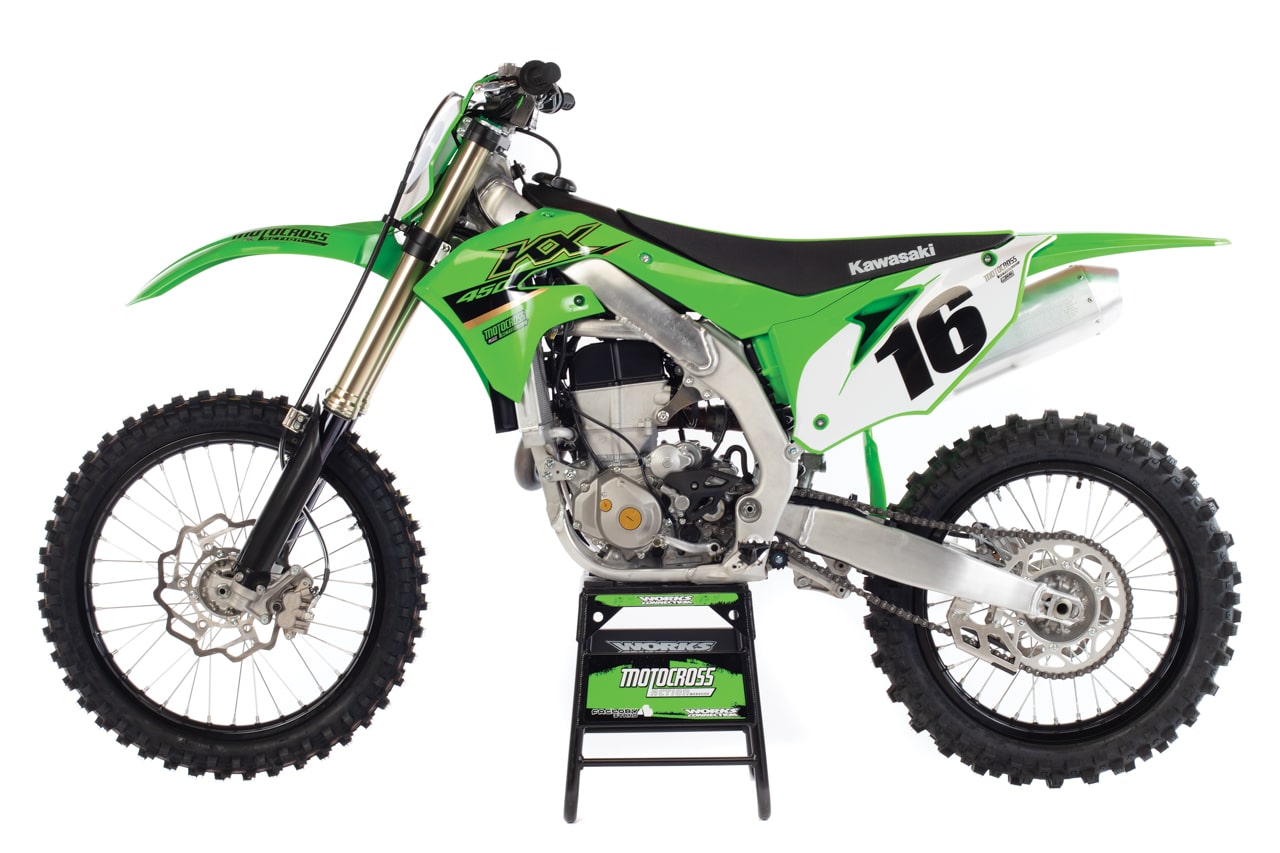 In 2021 the KX450 only received minor changes because all the R&D money went to the then-new KX250. We don’t know what they were saving R&D money for in 2022, but only the radiator graphics are different.
In 2021 the KX450 only received minor changes because all the R&D money went to the then-new KX250. We don’t know what they were saving R&D money for in 2022, but only the radiator graphics are different.
Q: HOW DOES THE 2022 KAWASAKI KX450 RUN ON THE TRACK?
A: The 2022 KX450 powerplant delivers a nice, pleasant, brisk, nonconfrontational style of power that is popular with the MXA test crew. It offers brisk, clean, light and quick-revving throttle response. In real dirt, the KX450 produces a nice spread of power that jumps from the low-end to the midrange to the top-end with little or no hesitation. It delivers the proper amount of power for the situation at hand. The delivery is extremely usable.
There are, however, some issues with the 2022 KX450’s power. First, throttle response at low rpm is jerky. The engine has a weird hit when the throttle is first turned. Second, the Kawasaki KX450 engine isn’t very powerful. Luckily, the lower power delivery allows the rider to try harder, go in deeper and get on the throttle sooner. Third, as much as MXA test riders like the 2022 KX450 engine, it makes less horsepower than almost any other 2022 450 motocross bike (save for the RM-Z450). The KX450 peaks at 56.9 horses at 9500 rpm. That doesn’t sound too bad, but the 2022 Yamaha YZ450F peaks at 58.5 horsepower, the Husqvarna FC450 at 58.4, the KTM 450SXF at 58.3, the Honda CRF450 at 58.1 and the GasGas MC 450F at 57.3. The 2022 KX450’s 56.9 horsepower does beat the RM-Z450’s 54.4 horsepower, but that is hardly a resume builder. Fourth, in motion, the KX450’s best power is from 6000 rpm to 9000 rpm, but from 9500 rpm and up the powerband could use some help.
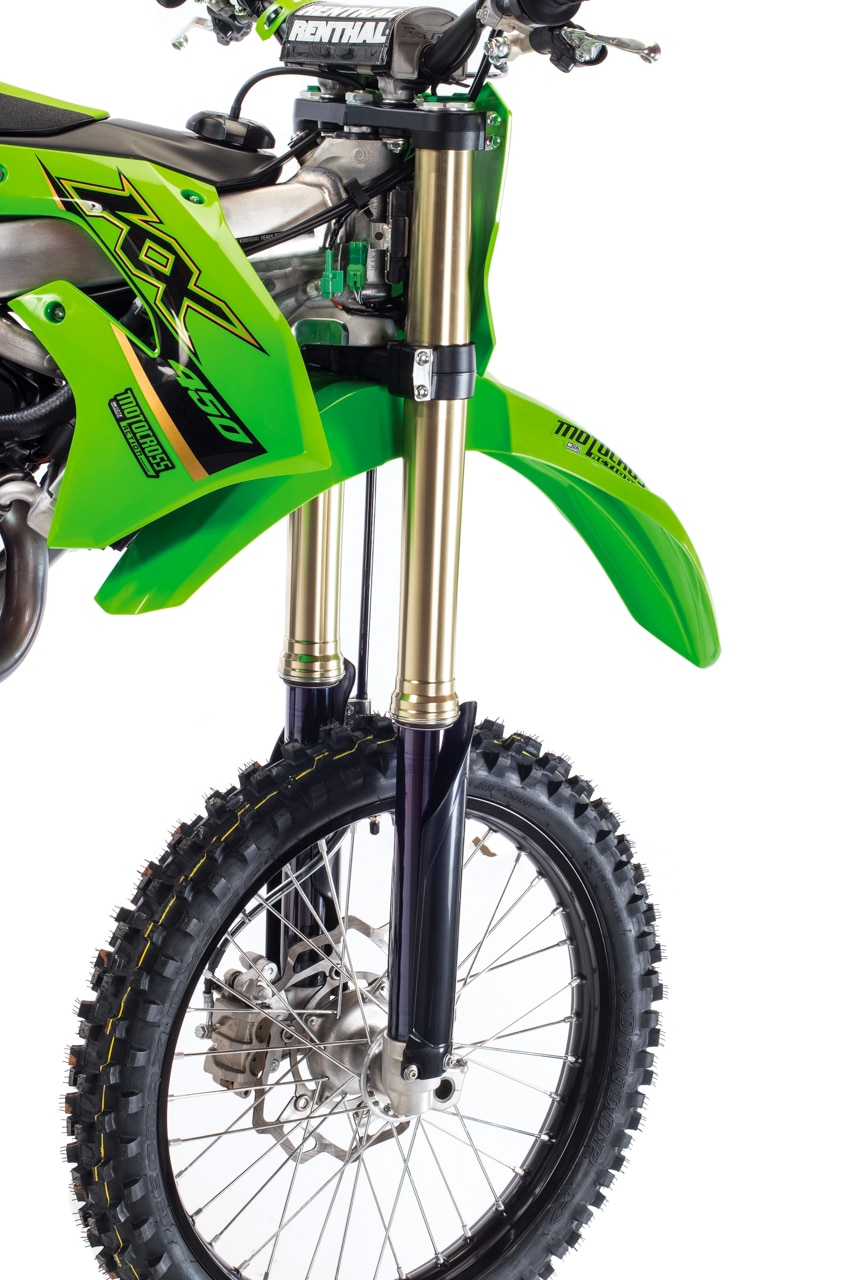 The 49mm Showa forks are too soft. Why wouldn’t they be? They were too soft in 2020, too soft in 2021 and totally unchanged for 2022.
The 49mm Showa forks are too soft. Why wouldn’t they be? They were too soft in 2020, too soft in 2021 and totally unchanged for 2022.
Q: HOW DOES THE 2022 SHOWA SUSPENSION PERFORM?
A: As a basic fork, the 49mm Showa A-kit-replica coil spring forks are the same units found on the Suzuki RM-Z450 and Honda CRF450 but with different valving. As they roll off of the showroom floor, they are plush, comfortable and follow the ground well; however, they are too plush, too comfortable and follow the ground too well to work for anyone but a light-weight Novice, comfort-seeking Vet or play-riding slow-poke. No MXA test rider, from a fast Vet to a quick Intermediate to an AMA Pro, could race with these forks in their stock setup. They bottom hard and bounce off the ground on rebound.
In short, the slower the test rider, the more he liked the KX450 forks. Conversely, the faster the test rider, the less he liked the KX450 forks. Novices and Vets loved the plushness so much that they didn’t mind the occasional clank.
Q: HOW DOES THE 2022 KAWASAKI KX450 HANDLE?
A: Face it, with forks this soft, the 2022 Kawasaki KX450 is only going to feel good when there are no big jumps, big bumps or big downhills on the track; however, once you get the forks stiffened up, by either the low-cost method of adding stiffer fork springs or the high-end solution of sending them out to your favorite suspension guru, the KX450 chassis can come in its own. Like most modern motocross bikes, the KX450 works best when the front and rear suspension are balanced and the chassis is flat and level.
Of all the aluminum-framed motocross bikes, the Kawasaki chassis is the most forgiving. It is not as supple as the chromoly steel frames on the Austrian machines, but it is light years more absorbent than the rigid Suzuki, Honda or Yamaha frames. It has a nimble feel and is easy to move around on the track.
 To be the 450 of the Year, the KX450 needs better forks, a smaller rear rotor, advanced electronics, improved durability, a stronger chain roller, better plastic and more actual horsepower.
To be the 450 of the Year, the KX450 needs better forks, a smaller rear rotor, advanced electronics, improved durability, a stronger chain roller, better plastic and more actual horsepower.
Q: WHAT YOU NEED TO KNOW ABOUT THE 2022 KAWASAKI KX450 ENGINE
A: Every bike has its own personal peccadilloes. Here are the things we watch on the 2022 Kawasaki KX450 engine.
(1) Maps. To change maps on the 2022 KX450, Kawasaki supplies several plug-in couplers. The green plug-in is the stock KX450 map, and it delivers the best all-around power. The black coupler mellows out the complete rev range and gives up 1 to 2 horsepower from 6000 rpm all the way to 11,500 rpm. The white plug-in is the aggressive coupler. It produces the exact same horsepower from bottom to top as the stock green coupler but delivers the power with a crisper feel (and a little less over-rev).
(2) ECU mapping. Kawasaki does offer a $700 mapping tool that allows riders to access 10 pre-programmed Kawasaki maps (three of which mimic the green, white and black couplers). It also allows a savvy owner to create his own maps, but unless you are running a race team, it’s simpler and cheaper to send your black box to Twisted Development to have them put special maps in for you. Yes, you have to pay for the service, but it isn’t $700.
(3) Clutch. The 2021–2022 KX450 clutch has a large 146mm clutch basket, which allows for 7mm-larger clutch plates. Kawasaki got rid of its horrid judder spring system and replaced it with a full-size eighth plate. And, finally, Kawasaki replaced the five individual coil-type clutch springs with a large-diameter Belleville washer. Unlike with five separate coil springs, the larger Belleville washer applies pressure to the clutch pack evenly around its circumference.
(3) Launch control. The KX450’s Launch Control button retards the ignition timing above 7000 rpm to knock off as much as 4 horsepower, which helps riders maximize traction off the gate. Launch Control is activated by pressing and holding the launch control button, located on the left handlebar, for two seconds while in neutral, first or second gear. When activated, the indicator light next to the button flashes to let the rider know the system is engaged. The system automatically disengages when the transmission is shifted into third gear, switching it back to the normal engine map.
(4) Overheating. We run a 2.0 kg/cm2 Twin Air Ice Flow radiator cap to keep the radiator from spewing fluid.
(5) Neutral. To get the KX450 into neutral on the starting line, we had to rev the engine and snick the shift lever at max rpm. Paradoxically, every MXA test rider appreciates a bike that has a hard-to-find neutral when he is grabbing gears on the face of jumps.
(6) Clutch plates. The 2022 KX450 clutch now requires three different clutch plate part numbers. The outer and inner fiber plates are different from the six middle plates. This does make clutch changes unnecessarily complex.
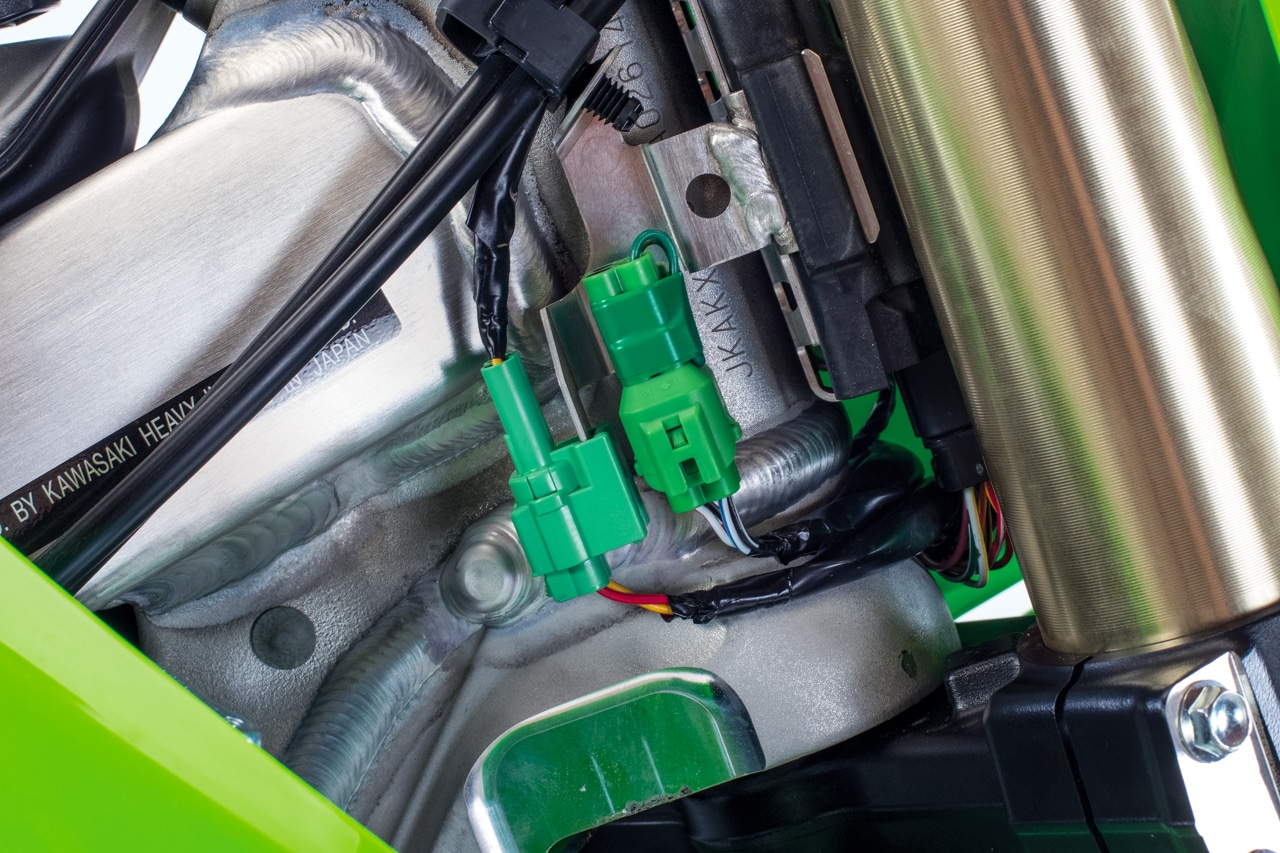 Most MXA test riders prefer the stock green coupler.
Most MXA test riders prefer the stock green coupler.
Q: WHAT YOU NEED TO KNOW ABOUT THE 2022 KAWASAKI KX450 CHASSIS
A: Every bike has its own personal peccadilloes. Here are the things we watch on the 2022 Kawasaki KX450 chassis.
(1) Handlebars. Kawasaki’s marshmallow-like, rubber, bar-mount inserts are useless. They twist and deform in even the smallest crashes. We replace them with stiffer aftermarket bar-mounted rubber inserts.
(2) Rear brake rotor. Kawasaki’s engineers spec’ed a jumbo-sized 250mm rotor on the 2021–2022 KX450. The big rear rotor lacks modulation. It is too grabby. There is no brake, and then there is too much brake. We ground the brake pad’s leading and trailing edges down at a 45-degree angle to ease their interaction with the rotor. We are surprised that Kawasaki’s engineers didn’t spec the smaller 240mm rotor that they put on the 2022 KX250 and KX450X. You could make the swap to the KX250’s 240mm rotor, but it would cost $130 for the caliper hanger and $215 for the rear rotor. Or, you could learn to live with the grabby rear brake and save $345.
(3) Brake rotor tech. Before you ride your new KX450 for the first time, clean the front and rear brake rotors with brake cleaner (and wipe with a clean dry rag) to remove left-over manufacturing residue.
(4) Rear brake pedal. The rear brake pedal can be adjusted upward but not downward. This doesn’t affect riders who run their brake pedals high, but makes it hard for riders who prefer their brake pedals low. To cure this, we hacksawed three threads off the bottom of the threaded master cylinder rod to give the pedal more downward freeplay; that way, a boot can touch it without locking up the brakes by accident.
(5) Chain roller. The lower chain roller—the one under the frame that keeps the chain from whipping as it spins off the countershaft sprocket—self-destructs quickly. Considering Kawasaki’s long-term problems with its rear chain guide, you should order TM Designworks parts on day one.
(6) Airbox. The MXA test riders like the no-tools airbox covers of the GasGas, Husqvarna and KTM. Plus, Honda’s airbox cover comes off with one bolt, and Yamaha YZ450F’s cover comes off with a twist of a Dzus fastener. Access to Kawasaki’s air filter requires the removal of two bolts, an 8mm hex head bolt and a 10mm hex head bolt. Couldn’t Kawasaki’s engineers have spec’ed one bolt size to make life easier for the owner (and when you finally get in, the air filter arrangement is cramped and convoluted). One added warning, be careful when installing the lower 8mm bolt—it strips the threads on the aluminum subframe easily.
(7) Brittle plastic. Kawasaki specs very brittle plastic, especially the fork guards. They can be cracked by roost. Additionally, the front number plate cracks down the center, and the elongated arms of the radiator wings crack vertically. Order aftermarket plastic (especially the fork guards), because it is more durable.
(8) Shock preload ring. MXA has complained about KTM’s nylon preload ring for a decade. Guess what? Suzuki and Kawasaki copied it. On the KTM 450SXF, we use a long screwdriver to pry on the preload ring while using the frame as the fulcrum. Unfortunately, on the Kawasaki it is next to impossible to get to the preload ring, making it necessary to hit the fragile preload ring with a hammer and punch.
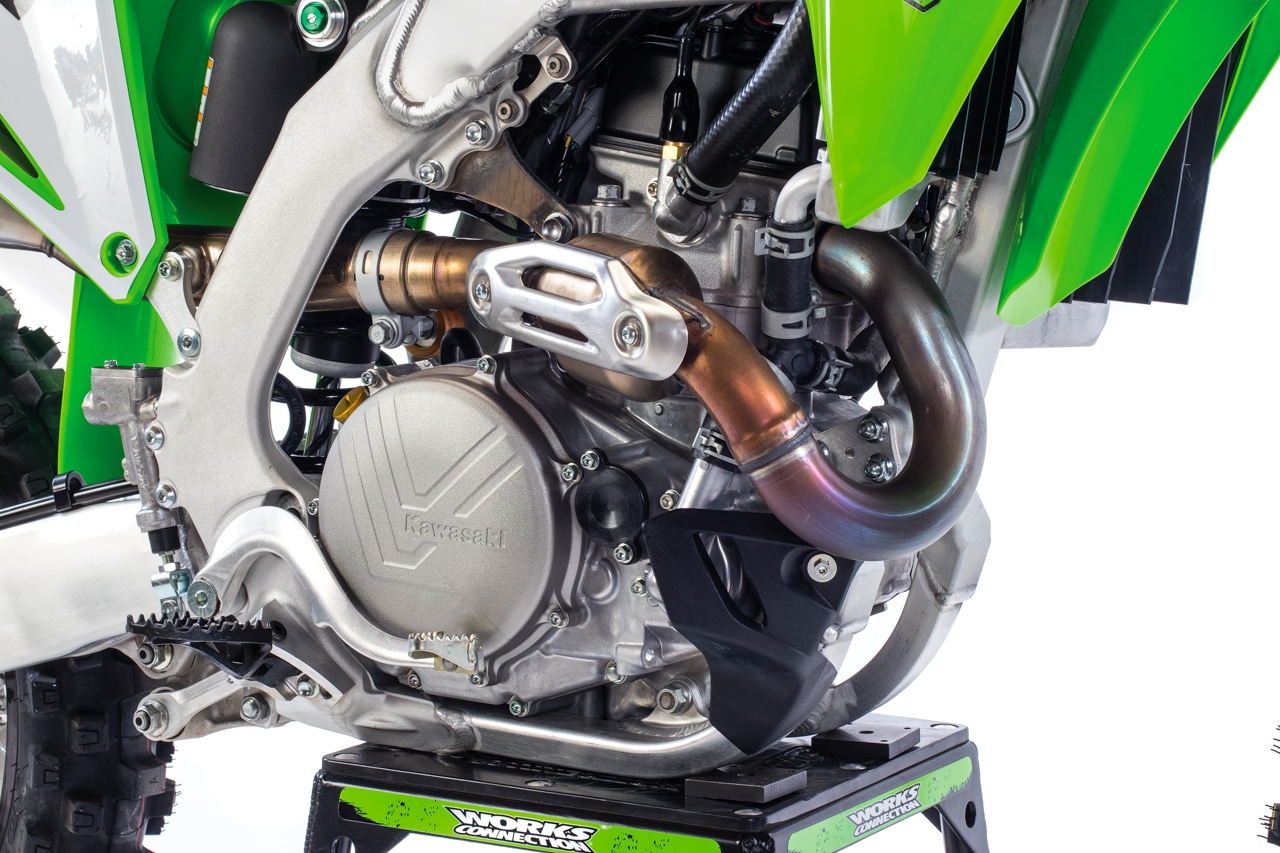 The 2022 KX450 engine has a brisk, light and clean-revving power delivery. It’s down a couple of horses to the big dogs, but its powerband is very manageable, save for the jerky hit off idle.
The 2022 KX450 engine has a brisk, light and clean-revving power delivery. It’s down a couple of horses to the big dogs, but its powerband is very manageable, save for the jerky hit off idle.
Q: WHAT DID WE HATE?
A: The hate list:
(1) Electronics. The 2022 Kawasaki KX450 is at the low end of the motorcycle industry’s electronics movement. Instead of push-button maps, they have old-school plug-in couplers. While several manufacturers offer Wi-Fi- or Bluetooth-accessible tuning, Kawasaki wants $700 for its calibration mapping tool. While Traction Control that can be engaged and disengaged to suit track conditions is on most of their competition, Kawasaki does not have a Traction Control button. It does have a Launch Control button.
(2) Muffler hanger. Keep an eye on the muffler hanger as the gunboat of a muffler puts a lot of strain on the aluminum tab. Don’t think that just because you switched to a rubber-mounted muffler you don’t have to worry.
(3) More power. Obviously, you can buy more power with aftermarket exhausts, head porting, high-compression pistons and ECU mapping, but, in reality, that is a zero-sum game. It does produce an increase in power and may bring the KX450 up to stock Honda, KTM or Yamaha levels, but only if those bike’s owners don’t do the same mods. It is the uniqueness of the KX450 powerband that makes it nimble, quick and such a joy to ride. Mess with it at your own risk.
(4) Durability. The exploding chain roller, splintering fork guards, stripped bolts, marshmallow bar mounts and cracked muffler hanger portend trouble ahead.
Q: WHAT DID WE LIKE?
A: The like list:
(1) Power. This is an incredibly nice powerband. If that sounds like a description of a potential blind date, that’s because the KX450’s power won’t knock your socks off.
(2) Finger-followers. The KTM was the first motocross bike to come with finger followers (small levers that activate the valves instead of rocker arms or buckets) over 10 years ago. Honda followed suit in 2017, and the Kawasaki KX450 joined the party in 2019.
(3) Plain bearings. Kawasaki also followed KTM’s lead when it switched to plain bearings, essentially bushings coated with an anti-friction material. They offer more surface area per contact patch, longer fatigue life, no brinneling and no moving parts—perfect for connecting-rod use.
(4) Handling. Once you stop the forks from blowing through the mid-stroke, the KX450 is a sweet-turning machine.
(5) Footpegs. The KX450F footpegs can be moved down 5mm if you so desire. On the new chassis, the lower position felt better.
(6) Weight. The 2022 Kawasaki KX450 is the second-lightest Japanese-made motocross bike on the showroom floors at 234 pounds. That makes it the fifth lightest bike after the GasGas MC 450F, KTM 450SXF, Husqvarna FC450 and Honda CRF450.
(7) Bar mounts. The rubber dampers need to be firmer, but the bars can be adjusted to four different locations. They come stock in the front holes with the bar mounts swiveled rear-ward, but most MXA test riders run the bar mounts in the rearward holes with the bars swiveled forward.
Q: WHAT DO WE REALLY THINK?
A: The 2022 Kawasaki KX450 is a nice, pleasant and fun race bike, but by no stretch of the imagination is this the best 450 motocross bike of 2022. If Kawasaki really wanted the KX450 to be the 450 of the year, it would have spec’ed better forks, a smaller rear rotor, advanced electronics, improved durability, a stronger chain roller, better plastic and more actual horsepower for 2022.
MXA’S 2022 KAWASAKI KX450 SETUP SPECS
This is how we set up our 2022 Kawasaki KX450 for racing. We offer it as a guide to help you find your own sweet spot.
SHOWA COIL SPRING FORK SETTINGS
The 2022 KX450 Showa forks are too soft. Kawasaki’s stock spring rate is 5.0 N/mm. It works for lightweight riders, Vet Novices and tracks without big jumps. There are three simple solutions. First, we suggest that Vet riders run a stock 5.0 spring in the right fork leg and Kawasaki’s optional 5.2 N/mm spring in the left fork leg. That adds up to a stiffer 5.1 N/mm spring rate. Second, faster or heavier riders can opt for Kawasaki’s optional 5.2 N/mm fork springs in both fork legs. Third, in truth, these forks could use a re-valve (without a spring change). We have included spring rates for Vets, Intermediates and Pros, but the stock spring would be sufficient if the KX450 forks had adequate compression damping. These are the numbers we ran on the 2022 Kawasaki KX450 for hardcore racing:
Spring rate: 5.1 N/mm (5.0 N/mm for light riders, 5.1 N/mm for Vet riders, 5.2 N/mm for fast riders)
Compression: 12 clicks out
Rebound: 12 clicks out
Fork-leg height: 2mm up (0mm)
Notes: If you have to race with the stock fork spring while waiting to get your forks fixed, slide the forks down in the clamps until the top of the triple clamp is even with the bottom of the fork cap. Be forewarned that you cannot fix the softness of the KX450 forks by going in on the compression clickers—that just introduces bad harshness at the end of the stroke. If you don’t think the KX450 is turning as well as it should, slide the forks up in the triple clamps to put more weight on the front wheel and steepen the head angle.
SHOWA SHOCK SETTINGS
The shock worked well from day one. We recommend this shock setup on the 2022 Kawasaki KX450 (stock specs are in parentheses):
Spring rate: 54 N/mm
Hi-compression: 1-1/4 turns out
Lo-compression: 18 clicks out
Rebound: 12 clicks out
Race sag: 105mm
Notes: The shock was easy as pie to set up. The rear end had minimal wallowing and worked very well under braking in chop and square-edged bumps. Light riders under 150 pounds might want to switch to the optional 52 N/m shock spring, while faster or heavier riders will need the 56 N/mm spring.


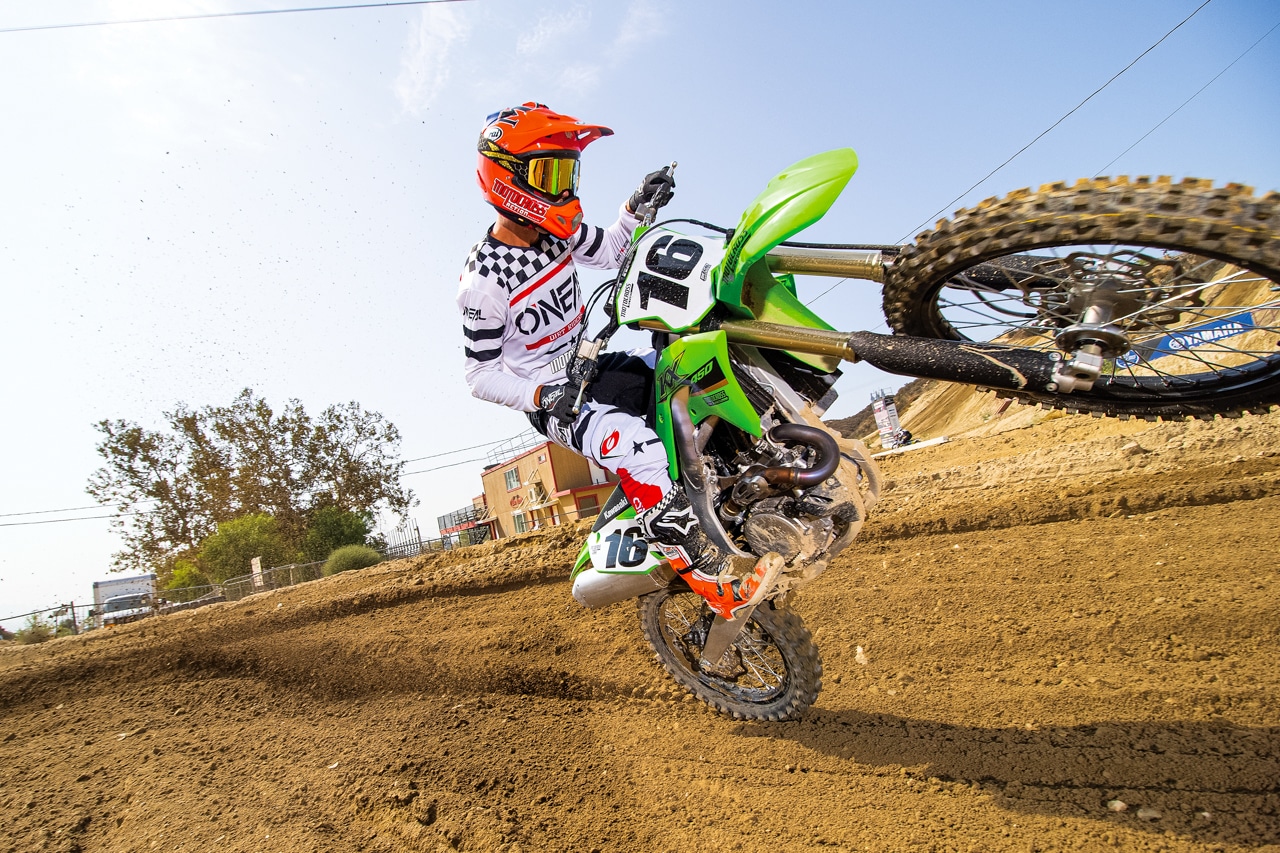
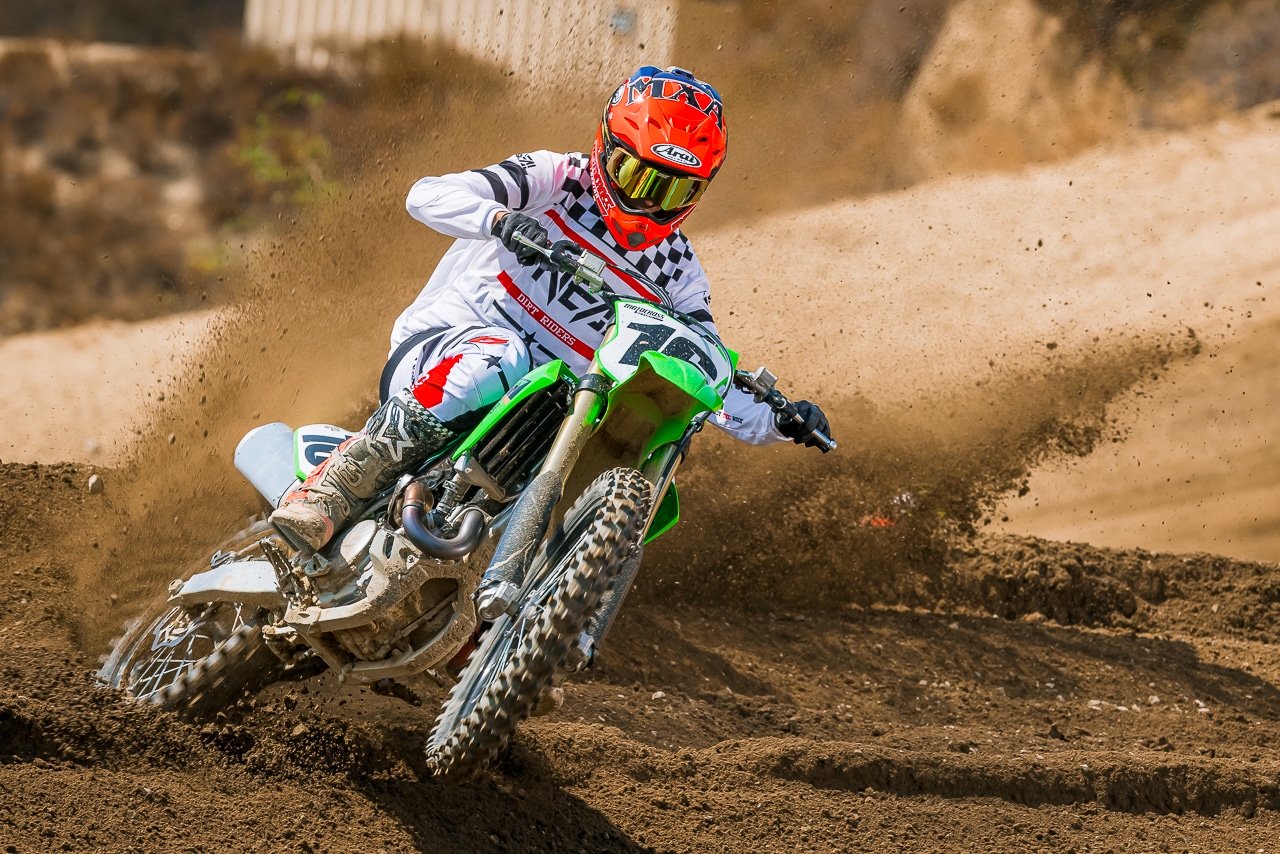

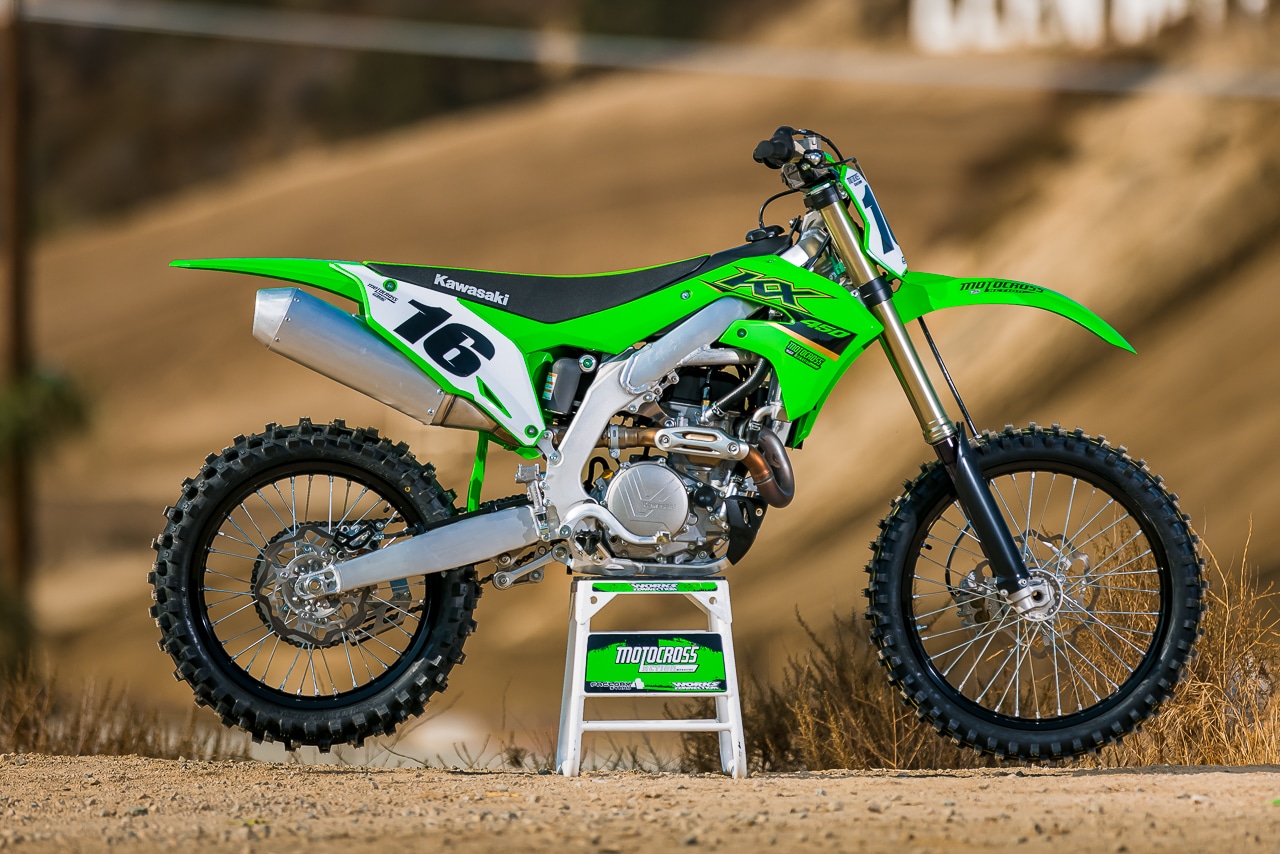
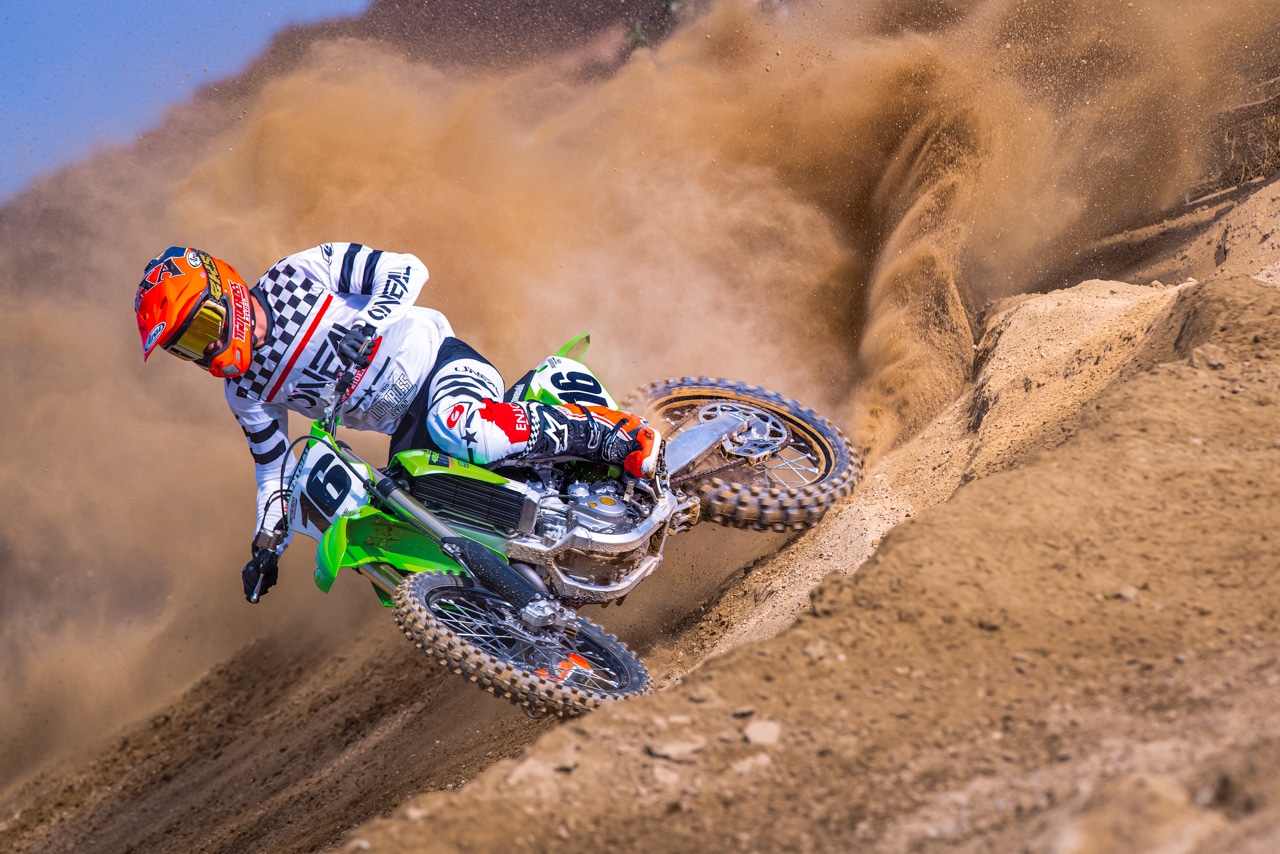



Comments are closed.